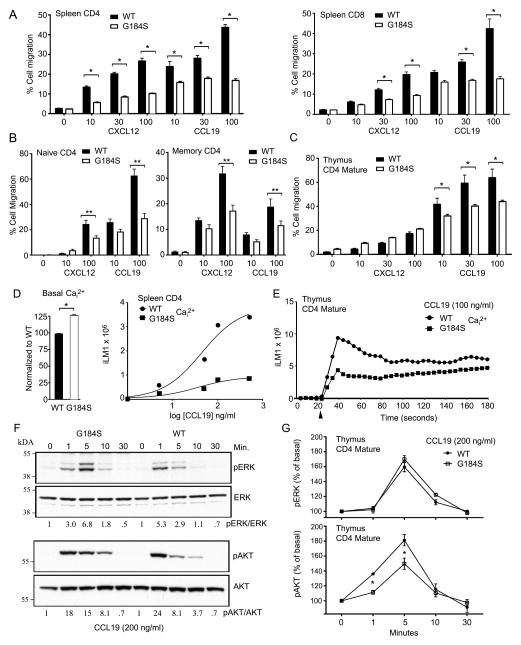FIGURE 3.
Decreased responsiveness of G184S splenic T cells and SP thymocytes to chemokines. (A) Migration assay to assess response of splenic T cells from mice previously reconstituted with a 1:1 mix of CD45.1 (WT) and CD45.2 (G184S) bone marrow. Data are expressed as % migrated in a two hour assay in response to increasing concentrations of the CXCL12 or CCL19. (B) Migration assay to assess response of memory and naïve CD4 T cells isolated from splenocytes prepared from WT or G184S bone marrow reconstituted mice. Data are expressed as % migrated in a two hour assay in response to increasing concentrations of the CXCL12 or CCL19. (C) Migration assay to assess response of mature thymocytes from mice previously reconstituted with a 1:1 mix of CD45.1 (WT) and CD45.2 (G184S) bone marrow. Data are expressed as % migrated in a two hour assay in response to increasing concentrations of the CXCL12 or CCL19. (D) Basal and peak intracellular calcium levels WT or G184S splenic CD4+ T cells in response to increasing concentrations of CCL19. Data plotted as peak calcium versus log concentration of CCL19. (E) Kinetics of the intracellular calcium levels following stimulation of WT and G184S mature thymocytes with CCL19 (100 ng/ml). (F) Immunoblot of cell lysates prepared from WT and G184S splenic CD4+ T cells stimulated with CCL19 (200 ng/ml) to analyze pERK and pAKT levels at various time points. The ratio between the phosphorylated (p) and unphosphorylated versions for each time point is shown below. (G) Flow cytometry to assess pERK and pAKT levels following the exposure of mature WT and G184S CD4+ thymocytes to CCL19 (200 ng/ml). (A), n=3 mice (B), n=3 vs 3 mice, duplicate determination. (C), n=3 mice (D), n=3 vs. 3 mice, duplicate determinations (E), n=1 vs. 1, duplicate determinations (F), n=1 vs 1 mice (G), n=3 vs. 3 mice, duplicate determination. All experiments were performed a minimum of 3 times. *p < 0.05, **p < 0.005 and ***p < 0.0005 (Student’s t-test).

